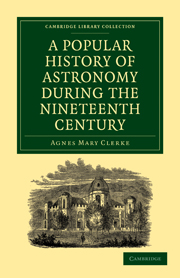Book contents
- Frontmatter
- PREFACE
- Contents
- INTRODUCTION
- Part I PROGRESS OF ASTRONOMY DURING THE FIRST HALF OF THE NINETEENTH CENTURY
- CHAPTER I FOUNDATION OF SIDEREAL ASTRONOMY
- CHAPTER II PROGRESS OF SIDEREAL ASTRONOMY
- CHAPTER III PROGRESS OF KNOWLEDGE REGARDING THE SUN
- CHAPTER IV PLANETARY DISCOVERIES
- CHAPTER V COMETS
- CHAPTER VI INSTRUMENTAL ADVANCES
- Part II RECENT PROGRESS OF ASTRONOMY
- INDEX
CHAPTER IV - PLANETARY DISCOVERIES
Published online by Cambridge University Press: 07 September 2011
- Frontmatter
- PREFACE
- Contents
- INTRODUCTION
- Part I PROGRESS OF ASTRONOMY DURING THE FIRST HALF OF THE NINETEENTH CENTURY
- CHAPTER I FOUNDATION OF SIDEREAL ASTRONOMY
- CHAPTER II PROGRESS OF SIDEREAL ASTRONOMY
- CHAPTER III PROGRESS OF KNOWLEDGE REGARDING THE SUN
- CHAPTER IV PLANETARY DISCOVERIES
- CHAPTER V COMETS
- CHAPTER VI INSTRUMENTAL ADVANCES
- Part II RECENT PROGRESS OF ASTRONOMY
- INDEX
Summary
In the course of his early gropings towards a law of the planetary distances, Kepler tried the experiment of setting a planet, invisible by reason of its smallness, to revolve in the vast region of (seemingly) desert space separating Mars from Jupiter. The disproportionate magnitude of the same interval was explained by Kant as due to the overweening size of Jupiter. The zone in which each planet moved was, according to the philosopher of Königsberg, to be regarded as the empty storehouse from which its materials had been derived. A definite relation should thus exist between the planetary masses and the planetary intervals. Lambert, on the other hand, sportively suggested that the body or bodies (for it is noticeable that he speaks of them in the plural) which once bridged this portentous gap in the solar system, might, in some remote age, have been swept away by a great comet, and forced to attend its wanderings through space.
These speculations were destined before long to assume a more definite form. Johann Daniel Titius, a professor at Wittenberg (where he died in 1796), pointed out in 1772, in a note to a translation of Bonnet's Contemplation de la Nature, the existence of a remarkable symmetry in the disposition of the bodies constituting the solar system. By a certain series of numbers, increasing in regular progression, he showed that the distances of the six known planets from the sun might be represented with a close approach to accuracy.
- Type
- Chapter
- Information
- A Popular History of Astronomy During the Nineteenth Century , pp. 93 - 114Publisher: Cambridge University PressPrint publication year: 2010First published in: 1885



